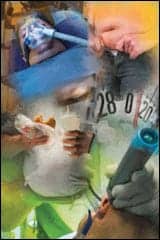
It’s five o’clock on a rainy Friday evening in a subacute unit with 10 ventilator-dependent patients who are in your care. After years of shift work, you find yourself reveling in your new position as a unit manager; you look forward to clocking out and singing “It’s Finally Friday” on your way home from work. That is when it happens: The lights flicker out, and you count to yourself, quietly waiting for the generator to kick in, “one thousand one, one thousand two, one thousand three,” then, as expected and tested, the safety lights illuminate and you are able to breathe again. Moments later, you hear the first “pop” of a circuit breaker failing, followed quickly by four more. It is a moment of panic that will not be forgotten. That’s when you ask yourself the critical questions: “What if we don’t have power?” “Where will these patients go?” “Are the hospitals prepared for this?” “Will our backup batteries last long enough?” “Who do we call?” “Who can manually ventilate?” “Where are the transport company phone numbers?” In short, “Are we really prepared for dealing with these patients in an emergency situation?”
Unprepared
The truth is that emergency preparedness for long-term care patients who are dependent upon sophisticated-modalities lifesaving equipment must be addressed long before the “Five O’Clock Friday” scenario above. In 1999, the American College of Chest Physicians (ACCP) published its consensus statement to address clinical criteria.1 In the statement, the ACCP clearly identifies the clinical stability of a patient prior to transfer and briefly identifies minimal safety requirements, such as generator availability. Additionally, federal guidelines mandate all skilled nursing facilities have emergency plans. These plans are evaluated annually and include items like disaster planning, generator testing, fire safety, and weather-related emergencies. The overriding issue that remains, however, is that most facility plans either are too vague or completely fail to address the specific needs of high acuity respiratory patients at all.
An example of flawed perception of a facility’s preparedness was revealed in the 2006 Department of Health and Human Services Office of Inspector General Nursing Home Emergency Preparedness and Response During Recent Hurricanes study.2 It found that even among those facilities with appropriate plans, “Administrators of nursing homes that evacuated, reported problems at each stage of the evacuation process, the most prominent including: transportation contracts were not always honored, evacuation travel took longer than expected, medication needs complicated travel, host facilities were unavailable or inadequately prepared, facilities could not maintain adequate staff, food and water shortages occurred or were narrowly averted, and prompt return of residents to facilities was difficult. In some cases, problems can be tied to a lack of effective emergency planning or failure to properly execute the emergency plans. In others, the circumstance’s effects on resources are not anticipated. Seventy-five percent of plans did not have information about the specific needs of residents that would allow staff to modify plans according to residents’ needs.” This last statement speaks clearly to the consideration of residents who have critical needs.
Again in 2008, national evaluation of emergency planning occurred after hurricane Katrina. The state of Florida was recognized as an outstanding performer with regard to emergency preparedness for long-term care facilities. According to a 2008 Florida Health Care Association (FHCA) publication, National Criteria for Evacuation Decision-Making in Nursing Homes, “The evacuation of a nursing home is an extremely serious undertaking with inherent risks to the residents the facility seeks to protect. The mass movement of persons during an emergency event who are often extremely frail, bed-ridden, comatose, cognitively impaired, and/or dependent upon ventilators or intravenous feeding or hydration equipment has considerable health implications. Nursing home residents have higher disaster-associated risks than other populations. Moving them out of harm’s way may well become a community imperative.”3
The FHCA has since written several national guidelines for long-term care facilities, but the gaps revealed in the 2006 and 2008 studies continue to exist with regard to the needs of medically complex patients. It is incumbent upon you as a respiratory care manager to help your facility take steps to ensure that they are fully prepared to care for and execute the needs of your complex patients in an emergency.
The Steps to Preparedness

- Assemble your internal team. This should be an interdisciplinary group that represents each of the facility’s departments. Be sure to include staff members and not just managers. What appears to be appropriate on paper may not be functional for actual staff. Also, be sure to identify a community liaison to communicate with external resources.
- Evaluate your equipment. This includes generator capacity and breaker configuration. In the “Five O’Clock” scenario, the breaker sizes were not adequate to handle two full loads of ventilator patient equipment. Even though the generator functioned properly, the breaker configuration failed. Evaluation of equipment, loading amps, and breaker capacity is paramount. Likewise, adequate and accessible oxygen backup as well as internal and external power sources (eg, battery-operated ventilators and suction machines) are critical for systematic and efficient decision-making. Knowing your equipment is capable of supporting patients for up to 8 hours allows evacuation performance to be a much more calculated event, thereby improving your odds for success.
- Determine your community resources. Whether emergency response requires internal or external evacuation, determining your community resources and including them in project meetings and plan development are crucial. According to the FHCA guideline, nursing homes are advised to identify three transportation providers. Representatives from the transportation companies, along with representatives from a minimum of two acute care facilities, should be involved in your planning meetings. For most ventilator patients, a trip to acute care means they are required to have an intensive care bed. Some community acute care facilities may be unable to meet the demand of several ventilator-dependent patients at once. Community providers should be fully engaged in the development of procedures to ensure proper execution.
- Develop and communicate your plan. Plan should include key elements such as:
- Command center identification (proximity to the subacute unit is preferable)
- Easily understood decision-making trees that include time frames in which decisions should be made as well as all necessary contact information for community resources. Each step should be clearly defined as to “when, who, and how” information should be communicated. In my experience, decision trees that do not include phone numbers often fail.
- Emergency preparedness checklist/documentation form that can be used throughout the incident for reference and postresponse evaluation.
- Readmission process: Clearly identify when and how residents will return to your facility.
Maintain and Update Your Plan

A series of workshops and project meetings should take place routinely to ensure that all information is up-to-date and accurate. The team should include a liaison that community resources can notify should they have changes that affect your safety plan.
- Communicate your plan. Each nursing station that is caring for high acuity respiratory patients should have access to the decision-making tree. The respiratory department should also have a copy along with department-specific decision trees for ancillary services.
- Safety planning and topics should be discussed at every staff meeting to ensure familiarity.
Education and training for manual ventilation, alarm systems, and patient monitoring recognition are paramount for patient safety. The lack of adequately trained support staff, including nursing assistants, greatly reduces the ability of the respiratory clinical team to carry out other critical patient care functions.
- Evaluate your plan through performance. The Center for Disability Issues and the Health Professions states, “Practice is very important; it increases skill and instills confidence in one’s ability to cope in an emergency. On September 11, 2001, one wheelchair user who did escape from the World Trade Center using an evacuation chair explained to the press that she had forgotten that the evacuation chair was under her desk. Two secretaries remembered and reminded her where it was.”4
Her forgetting about the device, combined with the experience of another wheelchair user who worked at the World Trade Center and recalled only a single demonstration of the device shortly after the 1993 bombing, indicates that the need for preparedness had worn off soon after the first attack. Whatever evacuation plan existed had not been practiced regularly. When disaster struck, the plan fell apart. Most of those who had been assigned to help with rescue devices were frightened and fled downstairs.
Keep in mind that the chief component of a drill is not only in its execution, but in evaluation of its efficacy. Postdrill evaluation and development of action plans for improvement are vital. Everything looks good on paper, but in reality, “Did it work?” “Why or why not?” These are questions that must be answered by your team.
Conclusion
While standards have been raised to ensure ventilator and high acuity respiratory patient safety in skilled nursing facilities,5 and many facilities have successfully achieved Quality Respiratory Care Recognition (AARC, QRCR guidelines),6 there still remains a gap when it comes to achieving ideal emergency preparedness. In the case of “Five O’Clock Friday,” all 10 patients were transported safely to area hospitals, electricians were called in to remedy the problem (and happy to do so at an “emergency/weekend hourly rate”), and the respiratory manager spent the next 72 hours delivering donuts to receiving hospitals and apologizing for the unanticipated need to place 10 ventilator patients at once. So much for that fictitious Monday through Friday management position! As respiratory care managers, it is our responsibility to lead our facilities into being expertly prepared when it comes to appropriate care of our patients in an emergency situation—even at five o’clock on a Friday.
Kendra G. Milliron, CRT, is clinical operations manager, Linde-RSS, US REMEO® subacute respiratory and ventilator weaning centers. Milliron has been a respiratory therapist for 21 years. Her experience includes level I trauma care, neonatal transport and therapy, as well as subacute rehabilitation and weaning. For further information, contact [email protected].
Reference:
- American College of Chest Physicians. Mechanical Ventilation: Beyond the ICU. 1999. Available at: www.chestnet.org/accp/patient-guides/mechanical-ventilation-beyond-icu. Accessed September 15, 2011.
- Department of Health and Human Services. Office of Inspector General. Nursing Home Emergency Preparedness and Response During Recent Hurricanes. 2006. Available at: oig.hhs.gov/oei/reports/oei-06-06-00020.pdf. Accessed September 15, 2011.
- Florida Health Care Education and Development Foundation. National Criteria for Evacuation Decision-Making in Nursing Homes. 2008. Available at: www.ahcancal.org/facility_operations/disaster_planning/Documents/NationalCriteriaEvacuationDecisionMaking.pdf. Accessed September 15, 2011.
- Center for Disability Issues and the Health Professions. Evacuation Preparedness Guide. Emergency Evacuation Preparedness: Take Responsibility for Your Safety. Available at: www.cdhp.org/evacuation/evacprep.html. Accessed September 15, 2011.
- AARC Position Statement. Delivery of Respiratory Therapy Services in Skilled Nursing Facilities Providing Ventilator and/or High Acuity Respiratory Care. Available at: www.aarc.org/resources/position_statements/delivery_of_services_in_snf.html. Accessed September 15, 2011.
- Finding Care. “Quality Respiratory Care Recognition” Means First Rate Respiratory Care. Available at: www.yourlunghealth.org/finding_care/qrc/qrcr. Accessed September 29, 2011.








